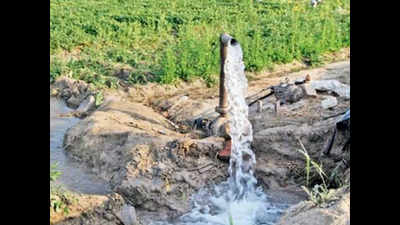- News
- City News
- delhi News
- More than half of Delhi suitable for groundwater recharge, finds report
Trending
This story is from March 14, 2021
More than half of Delhi suitable for groundwater recharge, finds report
Around 825 sq km of Delhi’s total area of 1,483 sq km has been identified as suitable enough for artificial recharge of the groundwater table, a new report by Central Groundwater Board (CGWB) states. While 190 sq km is roof area, 81 sq km is paved and the remaining is open, which can be utilised for the purpose.

Representative image
NEW DELHI: Around 825 sq km of Delhi’s total area of 1,483 sq km has been identified as suitable enough for artificial recharge of the groundwater table, a new report by Central Groundwater Board (CGWB) states. While 190 sq km is roof area, 81 sq km is paved and the remaining is open, which can be utilised for the purpose.
The report, which has been prepared for all states to bring up their water tables, stated that Delhi’s groundwater levels were currently declining at the rate of 0.2 metres each year.
“The high rate of population growth and high level of urbanisation has resulted in over-development of groundwater resources. Thus, in about 75% of Delhi, groundwater levels are declining at an alarming rate of 0.2m per annum. To increase the natural resource, rainwater harvesting and artificial recharge has become increasingly important in groundwater management,” it stated.
The city’s groundwater availability is controlled by hydro-geological conditions, such as the occurrence of quartzite that forms a part of the ridge and covers 145 sq km, which makes it tough to recharge the soil in the area. The older and younger alluvium soil covers 1,338 square km. Yamuna and its floodplain form the main drainage of around 97 sq km.
“The Yamuna floodplain has also been excluded as the water level is very shallow. It is proposed that excess floodwater may be transported to Chhatarpur basin, where the water level is deeper. A total of 22,706 recharge trenches with shafts, 3,04,500 rooftop rainwater harvesting structures and 12 check dams in hilly areas are proposed to be constructed,” the report stated.
Annually, Delhi receives 611.8mm of rainfall of which 533.1mm occurs during monsoon (June to September), making it a crucial time to ensure recharge. The report states that all locations where post-monsoon water levels are more than 5m below ground level can be considered for recharge purposes.
“Considering an 80% runoff coefficient for roofed areas, 60% for paved and 30% for open, the runoff availability is assessed at 175 million cubic metres (mcm). The surplus monsoon runoff from the Yamuna is 282 mcm. Thus, 457 MCM surplus runoff is available to recharge groundwater,” added the report.
The report, which has been prepared for all states to bring up their water tables, stated that Delhi’s groundwater levels were currently declining at the rate of 0.2 metres each year.
“The high rate of population growth and high level of urbanisation has resulted in over-development of groundwater resources. Thus, in about 75% of Delhi, groundwater levels are declining at an alarming rate of 0.2m per annum. To increase the natural resource, rainwater harvesting and artificial recharge has become increasingly important in groundwater management,” it stated.
The city’s groundwater availability is controlled by hydro-geological conditions, such as the occurrence of quartzite that forms a part of the ridge and covers 145 sq km, which makes it tough to recharge the soil in the area. The older and younger alluvium soil covers 1,338 square km. Yamuna and its floodplain form the main drainage of around 97 sq km.
Three types of recharge structures have been identified as suitable for the capital — trenches, rooftop rainwater harvesting and check dams for ridge areas. However, the report has omitted congested locations like Chandni Chowk, Daryaganj, Shahdara, Seelampur and Seemapuri, stating that plot sizes are either too small or there is not enough land available to make the recharge structures.
“The Yamuna floodplain has also been excluded as the water level is very shallow. It is proposed that excess floodwater may be transported to Chhatarpur basin, where the water level is deeper. A total of 22,706 recharge trenches with shafts, 3,04,500 rooftop rainwater harvesting structures and 12 check dams in hilly areas are proposed to be constructed,” the report stated.
Annually, Delhi receives 611.8mm of rainfall of which 533.1mm occurs during monsoon (June to September), making it a crucial time to ensure recharge. The report states that all locations where post-monsoon water levels are more than 5m below ground level can be considered for recharge purposes.
“Considering an 80% runoff coefficient for roofed areas, 60% for paved and 30% for open, the runoff availability is assessed at 175 million cubic metres (mcm). The surplus monsoon runoff from the Yamuna is 282 mcm. Thus, 457 MCM surplus runoff is available to recharge groundwater,” added the report.
End of Article
FOLLOW US ON SOCIAL MEDIA










